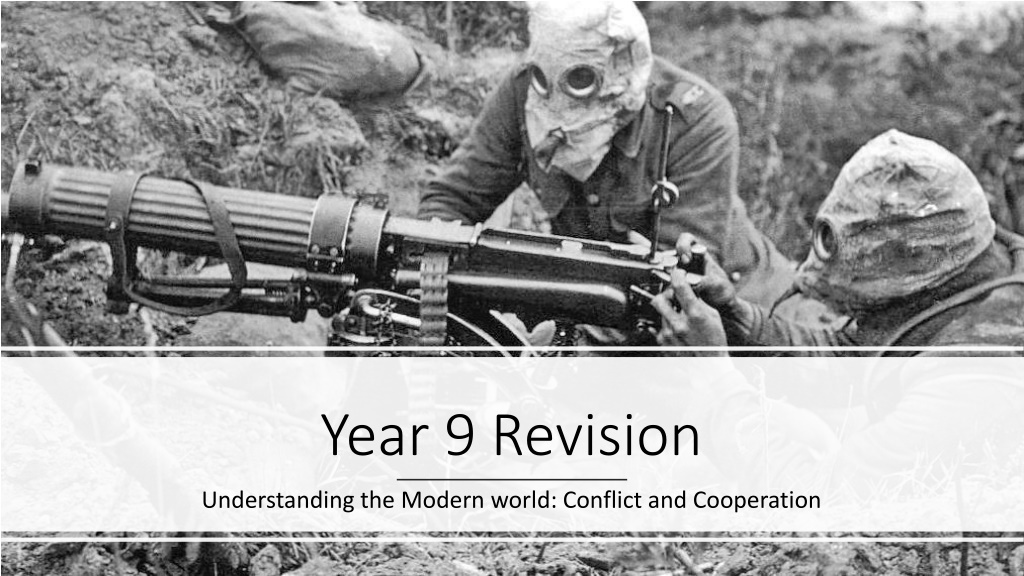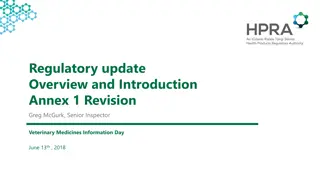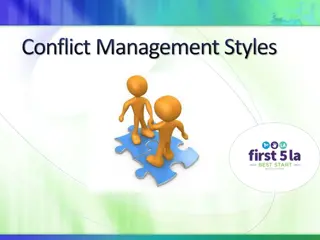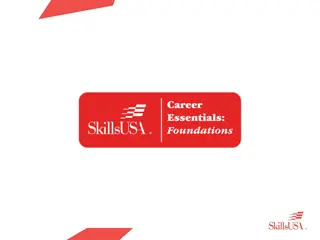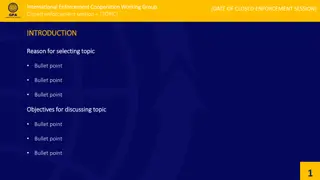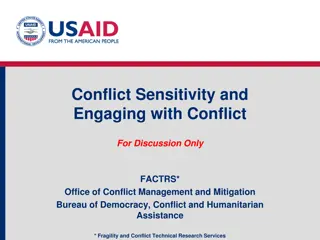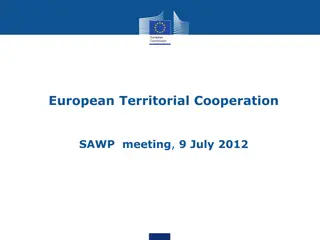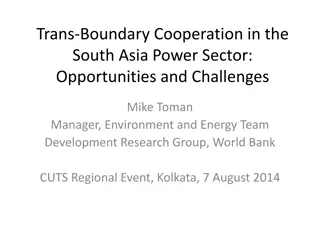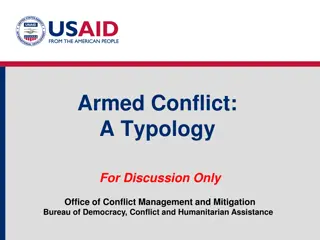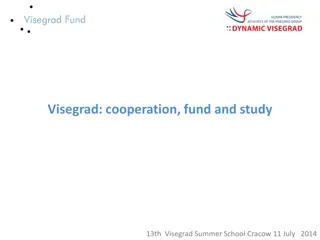Understanding the Modern World: Conflict and Cooperation in Year 9 Revision
This revision material covers various aspects of conflicts and cooperation in the modern world, focusing on World War I and World War II. It discusses the causes of both wars, life changes during the wars, the rise of totalitarian governments, the Holocaust, British involvement in WWI, trench warfare, and the impact on the homefront. Detailed information on recruitment, alliances, imperialism, nationalism, militarism, and key events like the Battle of the Somme are included.
Download Presentation

Please find below an Image/Link to download the presentation.
The content on the website is provided AS IS for your information and personal use only. It may not be sold, licensed, or shared on other websites without obtaining consent from the author. Download presentation by click this link. If you encounter any issues during the download, it is possible that the publisher has removed the file from their server.
E N D
Presentation Transcript
Year 9 Revision Understanding the Modern world: Conflict and Cooperation
Year 9 Year 9 - - Understanding the Modern world: Conflict and Cooperation Understanding the Modern world: Conflict and Cooperation How did WW2 differ to WW2? How did life change for people during WW1? What were the causes of the second world war? How far was the 20thCentury, America s Century/ Why did people turn to totalitarian governments and what was life like for the people living in them? How was the Holocaust allowed to happen?
Britain and the First World War Recruitment Causes of the First World War British expeditionary force. BEF A policy of extending a country's power and influence through colonization, use of military force, or other means. Entire units made up of people from the same local areas Imperialism Pals battalions Identification with one's own nation and support for its interests, especially to the exclusion or detriment of the interests of other nations. Nationalism From August 1914 a large volunteer army was needed to boost Britain s forces to around 2 million. Volunteers The belief that a country should maintain a strong military capability and be prepared to use it aggressively to defend or promote national interests. In 1916 all men between 18 and 41 were called up to fight. Militarism Conscription These were people who disagreed with fighting due to moral religious or political grounds. A union or association formed for mutual benefit, especially between countries or organizations. Conscientious objectors Alliances Archduke Franz Ferdinand Heir to the throne of Austria-Hungary who was assassinated in Sarajevo in June 194 Nickname given to the women who worked in the munitions factories. Canary girls The women's land army WLA Member of the Black Hand gang who assassinated Franz Ferdinand Gavrilo Princip German Emperor who gave the Austro- Hungarians a blank cheque to respond to the Serbians Kaiser Wilhelm 10 demands that Serbia had to meet or they would be attacked by Austria- Hungary Ultimatums German war plan designed to take France out of the war so they didn't have to fight on two fronts. Schlieffen Plan
Trench Warfare Fungal infection of the feet which came about from having little chance to keep feet clean and dry. Trench Foot PTSD. Men during WW1 were labelled cowards and often shot for cowardice. Shell Shock Name for Britain. To give yourself a blighty was to purposely injure yourself to get sent home. Blighty Corned beef. This was a staple of the meals on the front line. Bully beef Battle of the Somme 1. Lasted 5 months. First use of the tank in battle by the British. 2. The first day was known as the worst day in British military history with 56,000 casualties. 3. In total there were over 2 million casualties. 4. It was the first battle of Britain s Volunteer army 5. Whether it was a success or failure is argued about to this day. Many blame General Haig for the large amount of deaths and this battle led to the myth of the army being Lions led by donkeys . The Homefront Defence of the realm act which controlled all aspects of peoples lives. German Submarines. They sank ships of the coast and in the Atlantic in order to starve Britain into submission DORA U-Boat Voluntary in 1917, compulsory in 1918. Only a few products were included. The newspapers and books were censored to only report on positive features of the war. Rationing Censorship Giant balloon that flew across from Germany and dropped bombs on Britain. This was used to keep peoples spirit high during this Total war. Zeppelin Airship Propaganda
Weimar Germany 1919-1933 The New Democratic Government was established after the Kaiser fled to the Netherlands. It s first job was to ask for an armistice and then sign the treaty of Versailles. Germany was in so much turmoil it had to meet in the town of Weimar in Bavaria. Not the best of starts. How did the Nazis become more popular in the late 20 s and early 30 s? Weimar Republic timeline Left wing Spartacists take over Berlin and are defeated for the Weimar government be the Army supported by ex-service men known as the Free Corps. The Weimar government are forced into signing the Treaty of Versailles. This leads to many people believing that the Weimar government has betrayed the German people. Hitler Joined the German Workers party, later the National Socialist German Workers Party (NSDAP). Organisation of the Party Nazis would take control legally. 1919 The Kapp Putsch sees right wing nationalists trying to take Berlin. The Workers support the new government by going on strike. Hitler becomes leader of the Nazi Party s propaganda and speeches. They had 2000 members. Hyperinflation means money becomes worthless and people have to barter to buy goods. Many people starve as a result of the government s policies. Nazi s have 20000 members and feel in a position to launch an attempt to overthrow the government with the Munich Putsch. It is put down by the army who support the government. Hyperinflation is brought under control with a new currency and loans from the USA. Hitler spends 9 months in prison and writes his book Mein Kampf. He realises that he will need to get into power through legal methods (elected) 3% of votes are for the Nazis in 1924 elections and they win 32 seats Germany joins the league of nations and is therefore accepted by other countries to be a player on the world stage again. Weimar art and culture are flourishing; a night out in Berlin was meant to be one of the greatest experiences in the world. The Nazis lose popularity and gain only 12 seats in the Elections. 1920 Effective Speaker Hitler could command an audience when he made a speech Effects of the Great Depression 6 Million unemployed 1923 1924 Fear of Communism Middle-class feared losing their wealth Disillusionment with Weimar government Democracy didn t appear to be working. 1926 1928
Life in Nazi Germany 1939-1939 Keyword Definitions Information, ideas, or rumours deliberately spread widely to help or harm a person, group, movement, institution, nation, etc. Propaganda Restricting what is seen in books, plays, news reports, motion pictures, radio and television programs, letters, cablegrams, etc., for the purpose of keeping information out of the publics view on moral, political, military, or other grounds. Censorship A paramilitary organization whose methods of violent intimidation played a key role in Adolf Hitler's rise to power. Known as Brown Shirts. SA Originally established as Adolf Hitler's personal bodyguard unit. It would later become the elite guard of the Nazi Reich. Known as Black Shirts. SS Workers Women The Young The official secret police of Nazi Germany Gestapo Hitler offered the 6 million unemployed Bread and Work . National Labour Service was set up to get young men to work. Mass building programmes. Strength Through Joy provided cheap holidays and other benefits for workers. Raising a family was key. Women were encouraged to stay at home and were awarded medals for how many children they had. Loans were given out for marriages and didn t need to be paid back if you had children. Work and higher education were frowned upon and limited. School Boys were taught to become good Nazis Lessons focused on military skills Girls were taught how to run a home and how to produce perfect Nazi children with Aryan husbands. Nazi Ideology was in everything, and anti-Jewish info ran throughout the curriculum. Hitler Youth organisations meant boys and girls continued their indoctrination after school. The process of teaching a person or group to accept a set of beliefs without question. Indoctrination The process of teaching a person or group to accept a set of beliefs uncritically. Goebbels
Hitler was to blame Peace Making after WW1 World War I started in 1914 and fighting ended with the armistice on November 11th, 1918. The winners, Britain, France and the USA known as the Allies, then agreed to a peace treaty with the losers. Knowledge Organiser: Causes of World War II Terms of the Treaty of Versailles Hitler vowed to overturn Versailles and take Lebensraum (living space). This was the basis of his foreign policy and meant he would have to invade countries. This could start a war. He also vowed to make Germany strong again. and destroy Communism. Economic: Reparations for damage caused during war ( 6.6 billion). War Guilt Clause (Article 231) - accept blame. Loss of overseas territories (ports for trading). Military: Army restricted to 100,000 men. No modern weapons i.e. tanks, aircraft, U-boats. Limit of 6 battleships Territory: Alsace-Lorraine returned to France permanently. Demilitarisation of the Rhineland Saar, which was rich in coal, iron and steel was given to France for 15 years. The Treaty of Versailles Peace treaty created by the Big Three. Signed on 28th June 1919 at the Paris Peace Conference at Versailles Palace. Only dealt with Germany, who was not invited to the peace negotiations. The failure of the League of Nations Its structure and organisation made the League weak. Its lack of army meant it could not force nations to comply. Membership - countries could leave, the USA never joined and USSR and Germany were not allowed to join at first. Aims of the Big Three: David Lloyd George, Prime Minister of Great Britain wanted to make Germany pay because he knew that was what the British people wanted to hear. He wanted justice but not revenge. League of Nations The idea of American President Woodrow Wilson to bring the world together in peace. It would be a group of countries that would work together to solve world problems. Aims To stop war from breaking out again To encourage disarmament To improve working conditions To tackle deadly diseases The Great Depression The Wall Street Crash caused a decline in international cooperation. Desperate people turned to extremist parties and Leaders including Hitler and Mussolini. The League also could not afford to put effective economic sanctions on aggressors. Georges Clemenceau, the Prime Minister of France wanted revenge and to punish the Germans for what they had done. Keyword Definition Appeasement Armistice Allies An agreement to stop fighting A group of individuals/countries which work together A country's right to make own decisions Compensation for war damage paid by Germany Woodrow Wilson, the president of America wanted to make the world safe. He wanted to end war and establish lasting peace. The policy of appeasement aimed to prevent another war. Chamberlain believed this could be achieved through negotiation with Hitler and agreeing to his demands if they were reasonable. It failed to prevent war. Self-determination Reparations
WW2 Main Events Blitzkrieg Dunkirk Success Failure Timeline of WW2 1stSept 1939 Germany Invades Poland 340,000 allied troops rescued from the beaches 68,000 British were killed or wounded 3rdSept 1939 Britain declares war on Germany They had hoped to rescue 50,000 All the equipment were left in France. 10thMay 1940 The Germans launched an attack on France through Holland and Belgium. Navy worked hard The Fall of France happened 3 weeks after the evacuation of Dunkirk. April 1940 Germany launches attacks on Denmark and Norway eventually occupying both. 27,000 were rescued by civilian boats 26thMay - 4thJune 1940 Evacuation of Dunkirk. British soldiers leave France returning to the UK having been trapped at the coast near Dunkirk. D-Day 6thJune 1944 Planning Battle of Britain 22 June 1940 The fall of France. France surrenders to the Nazis. Photograph the coast. 1942 Battle of El Alamein begins the push to get rid of German forces in North Africa. Intense allied bombing of civilians in Germany begins. Pretend army. Spies give Nazi s the wrong details of the landing. 1943 Battle of Atlantic is effectively won when codebreakers work out how to find German submarines. Invasion of Italy Germany begins its retreat from Russia Floating harbours. Attack: Gold, Juno, Sword Beaches. 1944 D-Day, the allies land in France which is liberated by the end of the year. Soviet union push Germany back into Poland. 150,000 soldiers landed, some 4,400 died. 1945 Huge bombing of Germany. 100,000 die in bombing raids in Dresden. April: Hitler commits suicide. May 8: Germany Surrenders. The Atom Bomb Hiroshima 6 August 76,000 casualties Nagasaki 9th August 50,000 casualties Why drop the Bomb? Save allies from dying Justify spending so much Revenge on Japan Show USSR who was boss. But should they have dropped it? Why did the British win the Battle of Britain? Spitfire and Hurricane The many Radar
WW2 - Homefront Shortages Blitz Rationing After the battle of Britain the Germans turned to bombing industrial areas to destroy morale. 1940-41 was known as the Blitz. 44,000 died in London. Make do and Mend Pig Clubs Fuel Shortages Morrison and Anderson shelters were built and people used the underground. Conscription was introduced for all men except those in reserved occupations like ship building and coal mining. Black market In September 1939, around 1.5 million people, mainly school children, were moved from areas at high risk of bombing: big cities, industrial areas, ports and villages and towns near to airfields. Black out and air raid sirens were essential. The government encouraged the idea of the blitz spirit, people just getting on with everyday life. Women were conscripted into the labour service in 1941. Hours were long but millions more worked than did in the first world war Evacuees were usually separated from their families. Some evacuee children were badly treated or exploited. In 1944 the Germans launched V1 and V2 rockets towards Britain from mainland Europe. Women's land army employed 2 million The Empire provided many men to fight. 16,000 joined from the British Caribbean Evacuation saved many lives, but it had other important effects. It freed up many mothers to take on vital war work. The Indian Army proved very useful to British forces wherever it served. Recruitment was entirely voluntary and 2.5 million served in the in the Second World War. Many comfortable people outside the cities learnt how bad conditions in the cities were. After the war, they voted for politicians who wanted to stamp out poverty. Evacuation Recruitment
Americas Century Timeline of Events 1945-2001 1945 A -Bomb dropped on Hiroshima + Nagasaki. Key Term Definition 1948 Start of the Berlin Blockade ended in 1949 1949 USSR exploded her first A -bomb; Chinabecomes communist A theory or system of social organization in which all property is owned by the community and each person contributes and receives according to their ability and needs. Communism 1950-53 Korean War 1956 Hungary revolts against USSR and communism; they are crushed an economic and political system in which a country's trade and industry are controlled by private owners for profit, rather than by the state. Capitalism 1957 Sputnik launched by the USSR. This is the first man made satellite. a state of political hostility between countries characterized by threats, propaganda, and other measures short of open warfare. Cold War 1961 Berlin Wall built cutting of the capitalist west Berlin from west Germany Leader of the Soviet Union at the outbreak of the Cold War (1922-53) Stalin 1962 Cuban Missile Crisis begins when the USSR starts placing missiles on Cuba. Leader of the USA at the outbreak of the Cold War (1945-52) Truman 1965 -73 USA openly involved in Vietnam to stop the spread of communism. The idea that if one country falls to Communism that this will continue like falling dominoes until eventually the USA will fall. Domino theory 1968 USSR invades Czechoslovakia who have begun reforming their Communist government. The competition between the USSR and USA to show who had technological superiority by getting humans into space and ultimately the moon. 1969 Apollo 11 takes first men to the Moon Space Race 1979 USSR invaded Afghanistan the USA supplies weapons and aid to the Afghans. Guerrilla fighters of the North Vietnamese. Vietcong 1989 Fall of the Berlin wall 1991 Collapse of the Soviet Union Fighters who blend in and don t follow traditional army methods. They don t wear uniform and use improvised devices. Guerrilla Tactics 2001 The terrorist attack on the World Trade Centre The unlawful use of violence and intimidation, especially against civilians, in the pursuit of political aims. Terrorism
